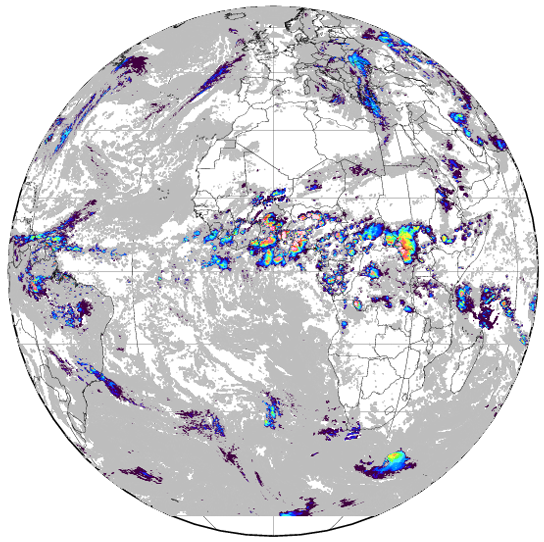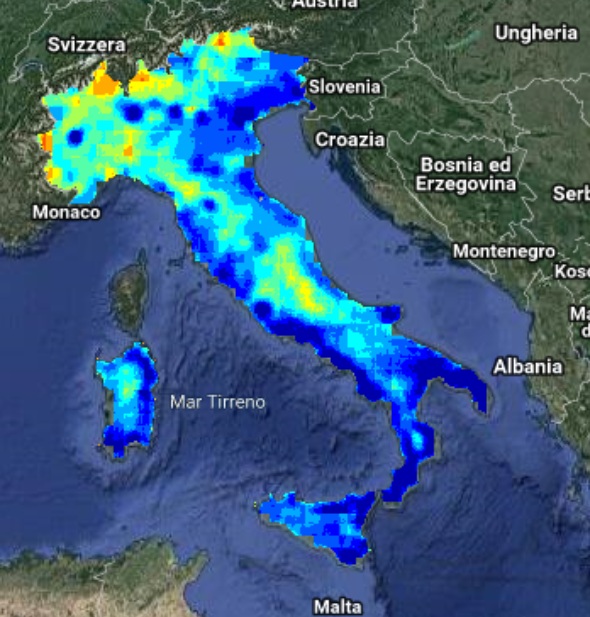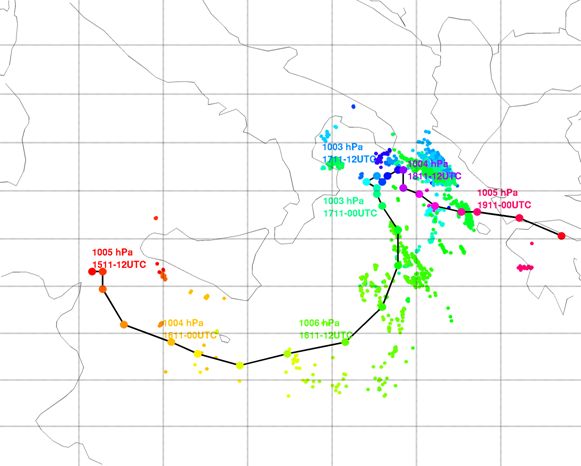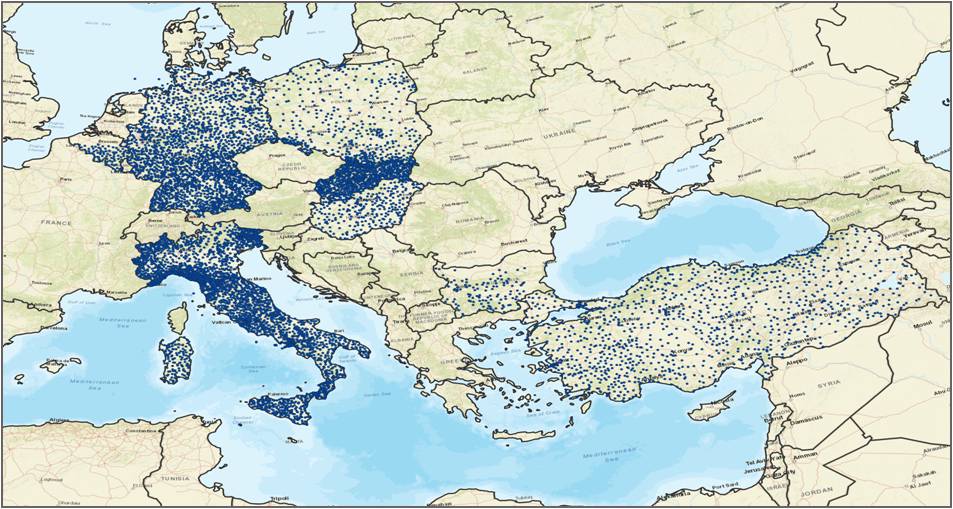Identify and interpret fields and derived products
Presentation 3 in the Marine Forecasting Course 2017
Length: 112 min
Author: Rasmus Tonboe (DMI)
Sea ice has always posed a threat to ships sailing through the northern Atlantic and also the ice was a clear indication of climate changes since the start of satellite observations in the 1970s. Satellites from their beginning have helped very much in tracking the condition and movements of ice sheets over North Pole and Antarctica. Sea ice condition, its melting and freezing over again in winter are important to track to see how they are affecting the weather and climate in these parts. Many satellite products and models were developed to distinguish thin one year ice from the thicker multiyear ice and to determine the actual thickness of these sheets. Further questions like how does ice affect radiation, how does snow affect the ice and what is the quality of the models that are used, will be answered during this lecture.
Presentation 2 in the Marine Forecasting Course 2017
Length: 117 min
Author: Ad Stoffelen
The lecture deals with modelled winds and winds derived from instruments onboard satellites like Metop-A and Metop-B in low orbits around the Earth (polar orbits). Today's models are evolving at a rate that is faster than the increase of density of observations and that presents a problem for forecasts. Here stands the question 'Will meteorology continue to develop and improve?'. The lack of observed data is thus filled with the data from satellites, although this data also has its own constraints due to the way it is derived. In the lecture the characteristics of the satellites carrying instruments for measuring winds and waves will be explained and the logic behind the calculations of winds using satellites will be discussed.
Scatterometer data are used for many different purposes in marine meteorology, e.g. warnings, enhancement of situational awareness for winds, monitoring of storm evolution, low pressure systems, etc., therefore marine forecasters using the products about wind and waves from satellites will be instructed how to use them and when to combine the data with model outputs.
Presentation 1 in the Marine Forecasting Course 2017
Length: 59 min
Author: Jean Bidlot (ECMWF)
Starting from the basics, this lecture introduces the students to wave model products (e.g. wave height and mean propagation direction), wave spectrum analysis, long swell forecasts, extreme forecast index etc. Since these outputs (alongside data from the buoys) are the basic material marine forecasters have for forecasting and nowcasting waves in seas and especially in oceans, explaining the positive and negative sides of model outputs is very important for understanding and thus correctly using the products marine forecasters use.
Length: 180 min
Authors: Pilar Ripodas (AEMet), Oscar Alonso (GMV), Cristina Ariza (GMV)
The NWC SAF has released a new SW package GEO v2016 in November 2016.
An online workshop was organized on 11 January 2017 between 9:00 and 14:00 UTC in order to introduce to the users the NWCSAF GEO v2016 from a technical point of view. The NWC SAF team explains how to install this new version, the organization of directories, auxiliary datasets, new output format...
Leo Pio D'Adderio presents two precipitation products based on passive microwave radiometry.
Length: 28 minutes
Passive microwave (PMW) radiometry is recognized as the most suitable for global precipitation monitoring and quantification. The H SAF precipitation products portfolio is being extended to provide Level 3 (gridded) PMW-based precipitation products to facilitate and promote the use of MW-based products for several applications. One of these products (labelled as P-IN-PWM, or H68) provides instantaneous precipitation rate estimates, based on calibrated and merged PMW Level 2 instantaneous precipitation rate products. H68 provides precipitation rate estimates every half hour, on a regular grid at 0.25°x0.25° resolution over the extended H SAF area (LAT 60°S – 75°N, LON 60°W – 60°E). The calibration is based on the precipitation estimates provided by the NASA Global Precipitation Measurement (GPM) DPR-GMI (Dual-frequency Radar and GPM Microwave Imager) combined product (2B-CMB). The H68 algorithm mainly consists of three modules (i.e. remapping module, adjustment module and merging module) that will be described. The other Level 3 PMW-based product that will be presented is P-DM-PMW (or H67), which provides as main output a 24 h mean precipitation rate based on the H68 product outputs. H67 provides data at the same spatial resolution as H68 at 00, 06, 12 and 18 UTC of each day for the previous 24 hours. Examples of H68 and H67 product outputs and applications will be provided.
Silvia Puca gives an overview on H-SAF activities and products.
Length: 28 minutes
H SAF products and applications fit with the objectives of services, agencies, authorities and other initiatives which need information on water at the ground in order to monitor hazards and natural disasters such as flash floods, landslides and drought conditions, as well as to improve water management. From 2005 H SAF started to provide remote sensing estimates of relevant hydrological parameters: instantaneous rain rate and cumulated rainfall, soil moisture at surface and in the root zone, snow cover and water equivalent. All products are available via EUMETSAT data delivery service (EUMETCast), or via ftp download; they are also published in H SAF website h-saf.eumetsat.int. The project involves experts from 12 national meteorological and hydrological European Institutes of Austria, Belgium, Bulgaria, Finland, France, Germany, Hungary, Italy, Poland, Romania, Slovakia and Turkey, and from ECMWF.
Luca Ciabatta presents an algorithm that retrieves precipitation amounts from soil moisture measurements.
Length: 19 minutes
SM2RAIN is a novel algorithm that allows to estimate rainfall from a different perspective, using the soil as a natural rain gauge. The algorithm has already been applied to several satellite soil moisture products both on a regional and global scale, providing high-quality rainfall data. Moreover, soil moisture-derived rainfall estimates have been found to be complementary to state-of-the-art top-down precipitation products. In this way, the integration of the two different approaches provides a more reliable rainfall product. Within H SAF, the SM2RAIN algorithm has been applied to Surface Soil Moisture (SSM) data obtained through Metop platforms. The SSM-derived rainfall data are then integrated with the Level 3 PMW H67 product. In this way, the integrated product P-AC-SM2RAIN (labeled as H64) can provide daily rainfall estimates with a spatial resolution of 0.25°, over the extended H SAF area (LAT 60°S – 75°N, LON 60°W – 60°E).
Silvia Puca presents how H-SAF products can help in an early warning system.
Length: 22 minutes
Many severe meteorological events occurred in Europe during the last decade and caused casualties and damages to the historical heritage and natural environment. The European Civil Protection agencies, supported by meteorological and hydrological institutes, aim to assess risk scenarios, to monitor and supervise events and risk levels, providing early warning to National and local authorities. Near real time accurate estimations of hydrological variables such as precipitation and soil moisture are invaluable for the hydrological risk evaluation, enable them to issue early warnings and plan for disaster relief at the local level. Besides measurements of key hydrological variables by ground-based instruments, often affected by a limited spatial coverage, advanced satellite-based precipitation and soil moisture products developed within different international programs as H SAF, are available and accessible to users in near-real time. Severe meteorological events are selected in order to understand how the main satellite precipitation product characteristics, i.e. accuracy, spatial pattern and resolution, update frequency and latency, impact the efficiency of a hydro-meteorological early warning system at a local level in an operational framework.
Jan Kanak talks about comparing H-SAF products against ground truth data and shows some examples over Europe.
Length: 32 minutes
For proper usage of satellite products in meteorological applications it is necessary to take the set of skills which can be divided into technical, logistic and routine work with data, and final application of meteorological knowledge base by means of interpretation tools. Our lesson will provide step by step introduction to validation work with the H SAF precipitation products, introducing BUFR, GRIB and NETCFD decoding, reading and upscaling with the aim to put these various satellite products into common grid suitable for comparison against essential precipitation measurements considered as ground truth. Passing through the validation process and being aware of the accuracy of satellite products, we will show the applicability of these data using selected show cases over Central Europe. Case studies were prepared to demonstrate possibilities but also shortcomings of satellite data, which users need to take into account in practical usage. Because the proper preparation of satellite products is not important only for validation process itself, but also for practical applications, using show cases we will explain how to merge together various sources of precipitation information, e.g. irregular rain gauge point data, regular radar grid data, satellite scanned grids derived from microwave and infrared imagers. We will discuss the special treatment of continuous and discreet parameters like precipitation intensity or accumulated rain versus precipitation phase, quality index and surface type’s parameters to be up-scaled into common grid. Once up scaled data can be merged with the aim to obtain the most probable final values of instantaneous and accumulated precipitation fields. Final message of this training lesson addressed to meteorologists and hydrologists will be targeted to understanding that precipitation must be considered as stochastic parameter describing complex 3D processes in the atmosphere.
Leo Pio D'Adderio talks about the so-called Mediterranean hurricanes (Medicanes) or tropical-like cyclones (TLCs) as well as the severe precipitation events associated to atmospheric rivers.
Length: 34 minutes
The Mediterranean Sea is recognized as a climatic hotspot, often affected by severe weather events that are becoming more and more frequent in the last decades. Extreme events originating over the Mediterranean Sea and hitting the coast can have tremendous impact both from hydrological point of view as well as in terms of human and economic losses. Among these events, increasing attention has been recently devoted to the so-called Mediterranean hurricanes (Medicanes) or tropical-like cyclones (TLCs) as well as to the severe precipitation events associated to atmospheric rivers. This presentation shows the potentials of H SAF products together with measurements collected by active and passive microwave sensors onboard LEO satellites for the characterization and monitoring of the precipitation associated to severe weather events during their different evolution phases.
Marco Petracca talks about the validation of H-SAF precipitation products.
Length: 31 minutes
The H SAF Precipitation Product Validation Group (PPVG) annually analyses all the operational precipitation products released by the consortium in order to check the quality and evaluate their performance over time. The Quality Assessment (Q.A.) service is carried out by comparison with precipitation data used as reference. The comparison over the Europe is performed with radar and rain gauge data belonging to eight European countries: Belgium, Bulgaria, Germany, Italy, Hungary, Poland, Slovakia and Turkey. The methodology used to evaluate the quality of precipitation products is common to all member states through the use of a same algorithm (named Unique Common Code). Over African areas the comparison is performed with respect to the Dual-frequency Precipitation Radar (DPR) products of the Global Precipitation Measurement (GPM). Data used, methodology applied, and results obtained will be presented.
Davide Melfi presents a method that blends GEO and LEO precipitation products.
Length: 19 minutes
The main precipitation products developed worldwide are based on microwave (MW) radiometry Microwave (MW) radiation is the most effective for precipitation retrieval because of the direct interaction of radiation with the frozen and liquid hydrometeors within precipitating clouds as opposed to visible or infrared observations sensitive to the upper portion of the clouds. However, as microwave instruments are currently only available on-board satellites in Low Earth Orbit (LEO), they do not provide a continuous monitoring of rainfall over a given location. One methodology is to combine geostationary and low orbit satellite observations. This kind of multi-platform algorithm provides global precipitation estimation merging high quality, sparsely sampled data from low earth orbit satellites (e.g. Metop, NOAA series, DMSP, i.e. LEO/MS in general) with continuously sampled data from geostationary satellites (e.g. GEO/IR). The presentation will describe an example of such retrieval techniques used in HSAF and the future approach in combining such different sources of data.












